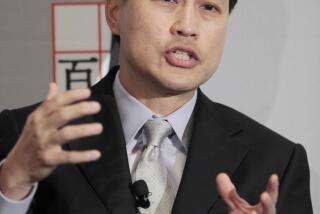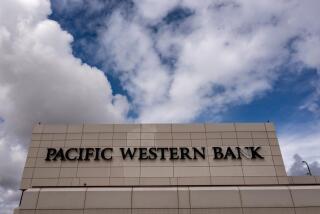Merger’s Primary Task: Soothe the Customers
Several years ago, when image-less Security Pacific National Bank was groping for a slogan that would make consumers feel good, its advertising agency concocted this phrase: “Your bank for life.”
Its customers have not only outlived that old ad slogan--they’re also now in position to outlive the bank.
On Monday, BankAmerica Corp. and Security Pacific Corp. announced that they planned to merge under the BankAmerica banner. Within six months, the name Security Pacific may well find itself in the same corporate name graveyard alongside such once-familiar firms as American Motors, PSA, Republic Steel, Western Airlines and Firestone.
Marketing experts say few consumers give a hoot about the technicalities of mega-mergers. But there are things they do care about. They care about the safety of their money. They care about the tellers they know. They care about local branches staying open. And they don’t want their bank to change its name.
This leaves both banks with a difficult marketing mission: Soothe the worries of customers.
“Customers have particularly personal relationships with their banks,” said Clive Chajet, chairman of the New York corporate identity firm Lippincott & Margulies. “Deciding what bank you bank at is much different than deciding what kind of mayonnaise you spread on your sandwich. When it comes to money, most people get very personal.”
And when it comes to overall image, neither bank is exactly a winner. In fact, the San Francisco corporate identity firm Landor Associates recently asked 5,000 consumers nationally to rank 2,000 corporate brand names by both familiarity and likability. In that poll, BankAmerica ranked only at No. 853, and Security Pacific rated at a lowly No. 1,652. Of course, no banks did very well in the poll, said Peter Farnell-Watson, executive director of the firm. The highest-ranking bank in the poll was Citicorp, which placed at the 700 spot, he said.
Meanwhile, it will be at least six months, or longer, before the proposed merger is approved or rejected. So, until that time, the banks must sit tight and keep separate identities. But in the meantime, corporate image experts say, they should closely study public opinion of their current identities, and they should also communicate a sense of calm to the public through their most valuable public relations tools: their employees.
“If I ask, ‘Gee, what’s going on?’ to the teller at my bank, and all I get in return is a quizzical look, I’m not going to feel very comfortable,” said David Stewart, marketing professor at USC. “Historically, in mergers, employees are the last to know what’s going on. But in this case, that would be a real mistake.”
Employees should at least be able to answer the most basic questions from customers. On Monday, in order to let employees of the banks know what is going on, BankAmerica’s Bank of America unit was distributing written details of the proposed merger, bank spokesman Peter Magnani said.
Marketing consultants also say the banks should designate specific employees at each branch who can answer more detailed questions. And they should also establish toll-free phone numbers for concerned customers to call.
“Any time one well-known name is replaced by another, you get lots of confused people out there,” Stewart said. “The banks must try to get the customer to believe that it’s for their benefit.”
One top ad executive said few consumers care about bank names. They care more about the people who work in the banks. “If a customer walks into the bank and their favorite teller, Martha, isn’t there, that bothers them,” said Clifford Einstein, president of the Los Angeles agency Dailey & Associates. So the banks--which are certain to cut staff--will have to deal with that issue.
Basically, the combined banks must eventually explain to customers why the merger is to their benefit, said Miles Turpin, chairman of West Coast operations of Grey Advertising, which had been BankAmerica’s agency until a new firm was recently selected. “You have to talk about what a bigger, stronger, more stable operation you are,” Turpin said.
For the time being, BankAmerica and its agency are both mum on future marketing plans. “The marketing challenges are complex,” Bank of America’s Magnani said. “It’s much too early to know our course.”
The merger would appear to be a windfall for Bank of America’s recently named agency, Ketchum Advertising/San Francisco. Some executives say the combined ad accounts of the two banks could exceed $50 million. “We haven’t even discussed this with them,” said Ken Dudwick, chairman of the agency. “We’re as surprised as everyone else.”
But James D. Helin, managing director of Security Pacific’s current agency, the Los Angeles office of D’Arcy Masius Benton & Bowles, says he plans to put up a fight for the ad business. “We fully intend to maintain a relationship with Security Pacific--or their successor.”
Pearlstein Hired by N.Y.-Based Agency
Los Angeles ad executive Leonard Pearlstein has landed a top post with a major New York-based agency.
Pearlstein, a founding partner of the now-defunct Los Angeles agency Keye/Donna/Pearlstein, on Monday was named president and chief operating officer of Lord, Dentsu & Partners. Pearlstein, 50, will work out of the firm’s Los Angeles office.
Pearlstein said his duties will extend coast to coast. Although the agency’s Los Angeles office has done quite well lately, its New York office has had its share of headaches. The agency’s car client Peugeot last week announced it would be pulling out of the U.S. market.
Indeed, one of Pearlstein’s most immediate jobs will be to help the agency land a new car client, said Dick Lord, chairman of the agency. Lord said the firm will join the chase for Pegasus, the luxury car that Mazda is expected to introduce within the next few years.
“We didn’t have that in mind when we hired him,” Lord said. “But since we lost our car client, it wouldn’t be a bad idea.”
More to Read
Inside the business of entertainment
The Wide Shot brings you news, analysis and insights on everything from streaming wars to production — and what it all means for the future.
You may occasionally receive promotional content from the Los Angeles Times.










